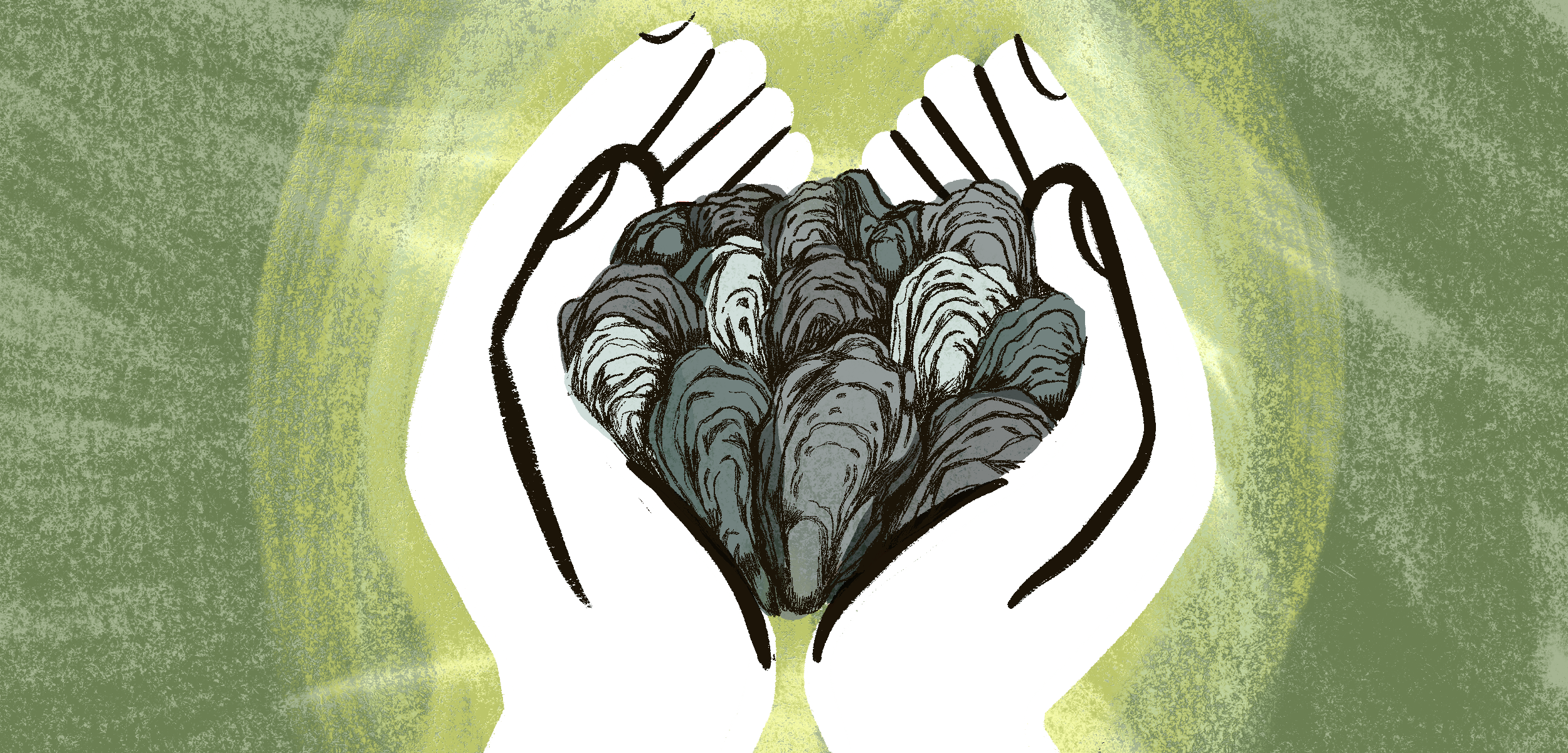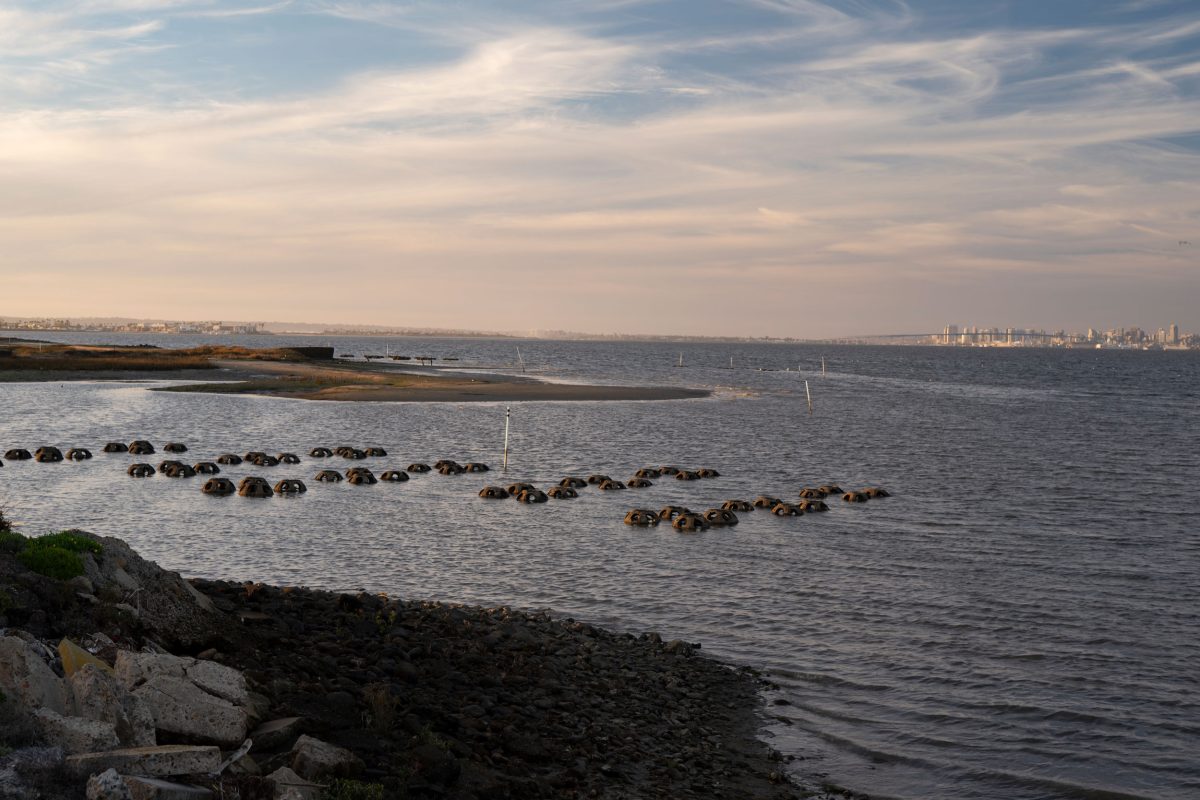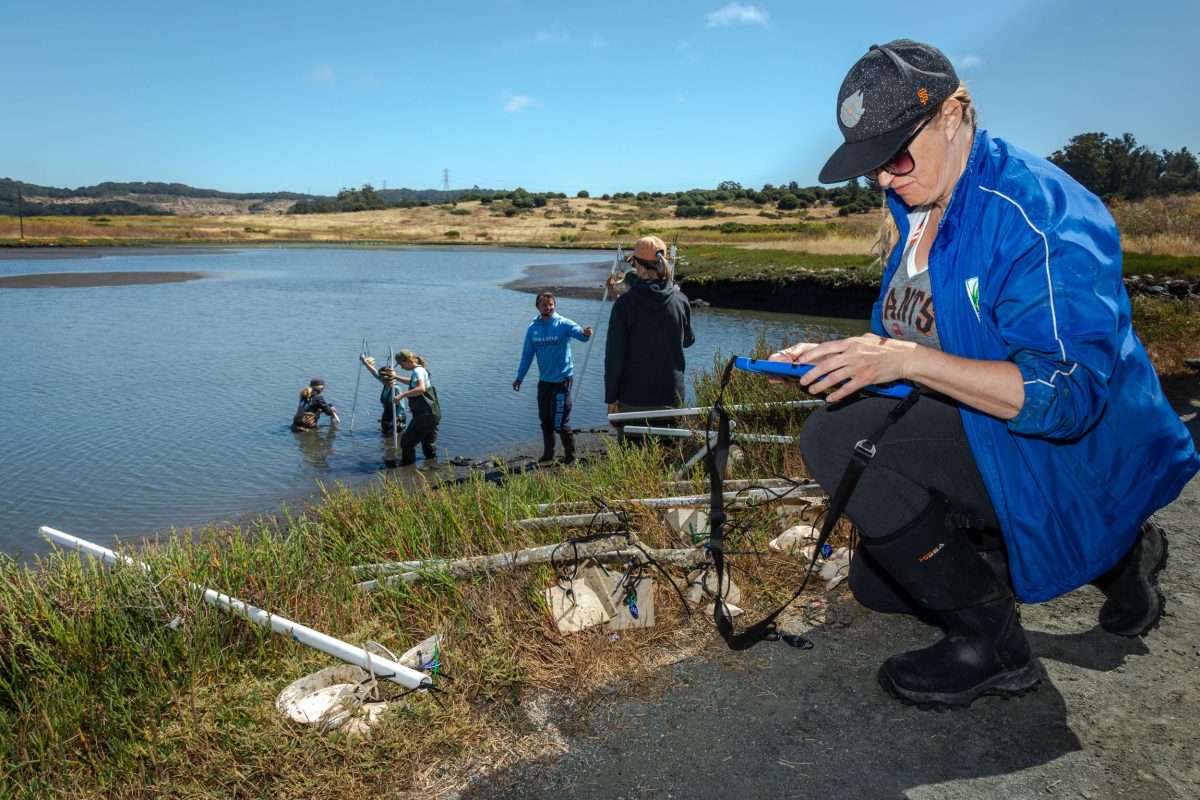How to Love an Oyster
The Pacific coast’s only native oyster is making a comeback, but it still needs a little help from its friends.
Article body copy
He called it the Olympia
And coined a word specific
Describing the Olympia
As simply “Oysteriffic”
—Jay Bolster, “Ode to the Olympia Oyster”
Most people, even those who know a thing or two about oysters and may perhaps enjoy eating them, have no idea that the sweet and buttery bivalves they are slurping down in San Francisco or Vancouver are not the native species of the West Coast but Japanese imports. It’s an easy mistake to make, considering that Japanese oysters (Crassostrea gigas) are commonly referred to as Pacific oysters—as in western Pacific—though they have been commercially cultivated in North American waters for nearly a century.
There may be no intentional deception at work, but if you’re anything like me, you must be disappointed to discover another hitch in your quest to do right by the ocean: eating locally caught, native seafood, preferably shellfish because their carbon footprint is low. Japanese oysters? Locally raised, yes. But this introduced species has spread so easily and become so common that you can find them rooted in places where no one has deliberately planted them. Our appetites have fueled this alien invasion. It is only on rare occasions at certain bougie establishments that you might encounter the much-smaller Olympia oyster (Ostrea lurida) on the menu, a Proustian remembrance with its miserly portion of meat and coppery taste.
“Olys” were once the Pacific oyster. They were sold in seafood markets up and down the West Coast in the late 19th and early 20th centuries. Coastal development, overharvesting, and polluting industries, mostly wood-pulp mills, resulted in the decline of their populations and their near-total erasure from the public consciousness. One study from 2011 describes them as being functionally extinct across most of the Pacific coast.
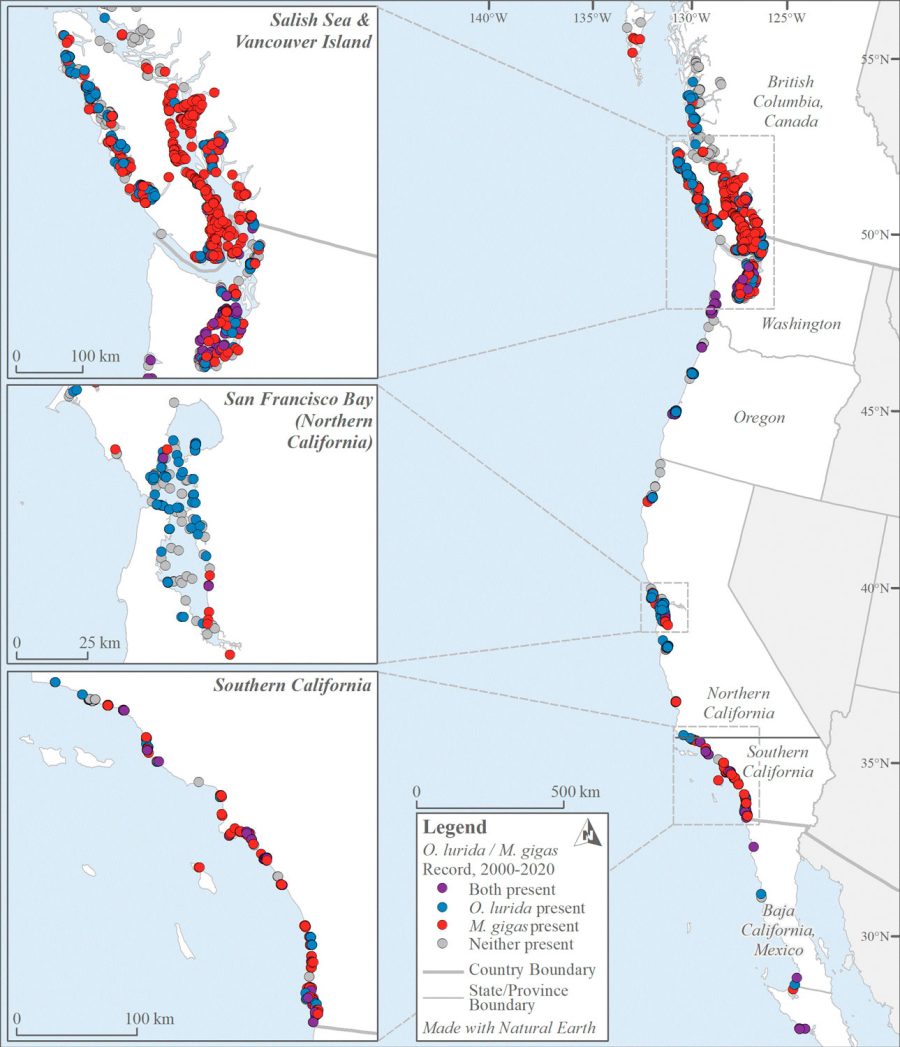
Pacific oysters from Japan supplanted Olympia oysters in bays throughout the native oyster’s habitat. Map by Aaron Kornbluth et al.
They aren’t unusual in that regard: scientists estimate that 85 percent of native oyster reefs around the world have been lost. But while efforts to protect and restore Atlantic oysters in the United States have received massive popular and federal support along the Gulf of Mexico and the East Coast, the fate of the Olys—a species that ranges from the middle of Baja California to Northern British Columbia—has been left in the hands of a few determined zealots.
And you pretty much have to be a zealot to love an oyster. Just about anyone can fall for a whale. A select few might grow fond of an octopus. An oyster, immobile and nearly brainless, is hardly even an animal, despite what the taxonomists tell us. Some plants possess more personality: They sport showy flowers, fuzzy leaves, colorful fruits. They grow and change with the seasons, luring in pollinators and herbivores. Loving an oyster is like loving a rock. And a person who advertises their love of Olys is like that insufferable friend who rides around town on a fixed-gear bicycle and listens to bands you can’t stream on Spotify.
But also, that friend sometimes has a point. There’s a whole world out there that you and I might benefit from knowing a little more about.

Olympia oysters, called Olys, are small but have a mighty taste. Photo by Bryan Chan/Los Angeles Times via Getty Images
Last fall, my editor suggested I spend some time with the zealots, starting with an afternoon symposium on Olympia oysters taking place at the annual meeting of the Western Society of Naturalists. Several dozen experts, representing 3,000 kilometers of coastline, packed into a conference room at a beachside hotel in Southern California.
One graduate student had used a special sensor to measure the heartbeat of an oyster in situ. Another had staked GoPro cameras into the shallows to see what kind of fish frequented an oyster bed. At one point, a group of marine biologists decamped from the festivities, crossed a four-lane road, and were delighted to confirm the presence of a few isolated urban Olys amid the sailboats moored at a harbor behind a residential development.
“There’s still a strong belief that there weren’t any here,” says Danielle Zacherl, an ecologist at California State University–Fullerton, referring to the Olys’s range in Southern California.
These researchers are all conducting objective, rigorous science. But it’s clear they’re also gunning for a particular outcome: proving to their families, their friends, and the rest of the world that the invertebrate indie band they care so much about is worth the trouble.
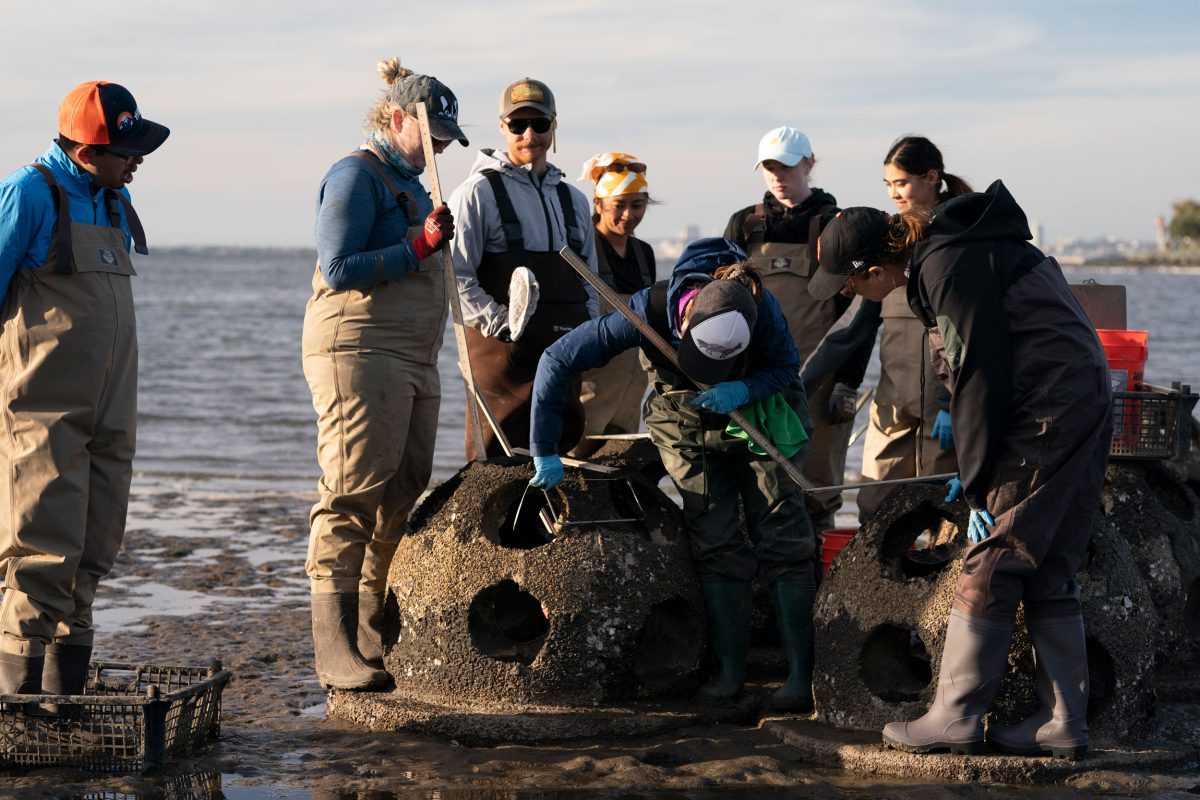
Danielle Zacherl, leaning over the reef ball, and her team work on an oyster restoration project in the Port of San Diego in California. Photo by Rob Hammer
“This species has a PR problem for sure,” admits April Ridlon, past coordinator of the Native Olympia Oyster Collaborative who’s now with the Monterey Bay Aquarium. “I think it’s hard for people to envision that these things are even alive.” At the very least, she says, we need to know what we will lose if these oysters vanish and what we might gain if we succeed in bringing them back.
When oyster populations are healthy, they spread billions of microscopic larvae that drift and sway with the currents before rooting themselves on terra firma, where they clean the water of detritus—including algae that they magically transform into sumptuous, edible protein. Like beavers or termites, they are ecosystem engineers, shaping the habitat where they live.
The Atlantic oyster, for instance, builds reefs off the coast that are over a meter in height and contain millions of individuals that, collectively, defend the shore from storm surges and erosion. Just one of those oysters can filter nearly 60 liters per day—200 liters in ideal conditions—providing the clear water that allows aquatic plants to grow and creating a nursery for young fish, crabs, and other marine species.
I could go on and on about the benefits of oysters, but a better way to develop an aficionado’s appreciation for “oysterhood” might be through the lens of a microscope. Like many marine invertebrates, oysters start their lives as a tiny, mobile larva that experiences the vastness of the underwater world with the help of chemical sensors and a single pigmented eyespot. “Those two weeks are his one taste of vagabondage, of devil-may-care free roaming,” M. F. K. Fisher wrote in her classic book, Consider the Oyster.
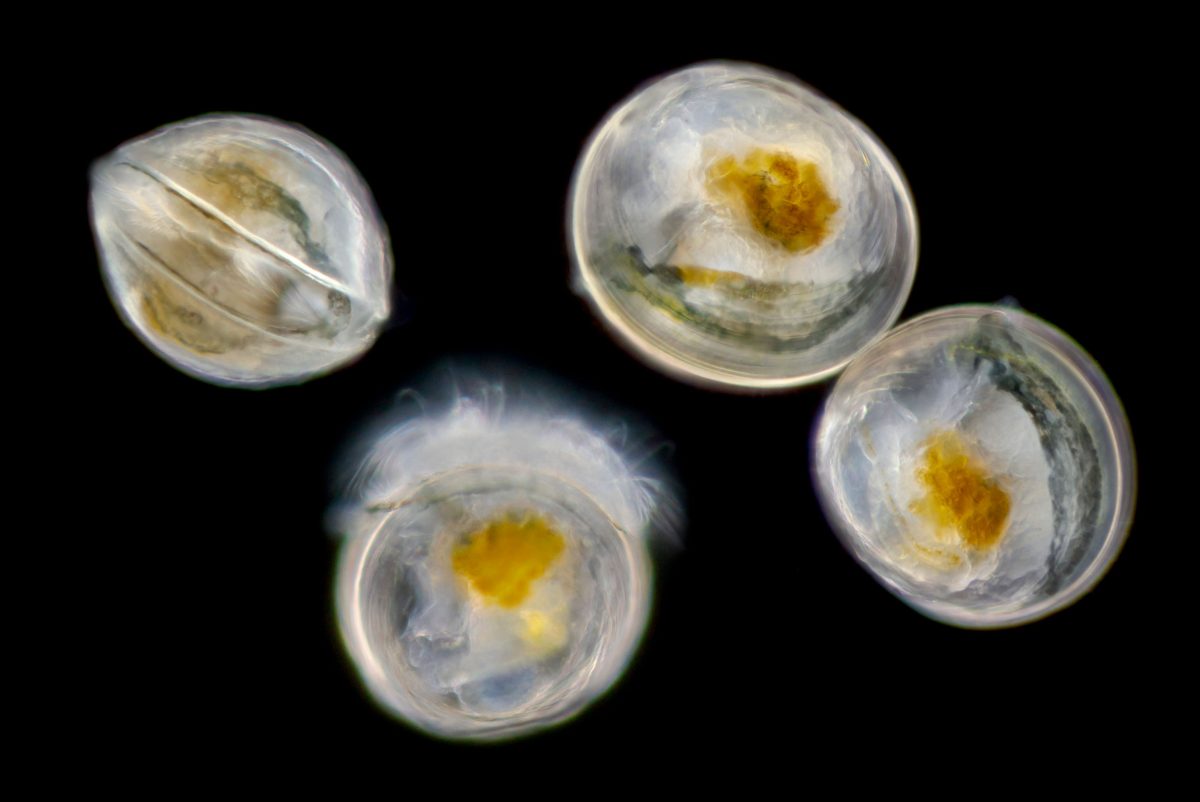
Oyster larvae are free-floating organisms looking for an ideal habitat in which to settle down and grow. Photo by Wim Van Egmond/Science Photo Library
During a visit to the Moss Landing Marine Laboratories near Monterey, California, in early 2023, I lean in and watch these hyperactive critters use their cilia to zip around and bounce off each other like bumper cars. My hosts, a group of marine biologists raising Olys in captivity, tell me the moment a larva settles down on a surface, he will never move again. (And it is a he, as most oysters begin life as a male and later switch sexes.)
At this point in their lives, the Olys, like all oysters, do us a favor. They become spat, a tiny version of their adult selves, less cute but more appetizing. To feed, they crack open their shells and use the abundant cilia on their gills to power the flow of water, capturing particles as they pass by and growing larger day by day. A “free gift from bounteous nature” is how one early 20th-century oyster partisan put it.
Judging from the piles of shells they left behind, the coastal tribes along the Pacific coast agreed: they took advantage of this bounty beginning at least 6,000 years ago. Once the Europeans arrived, they, too, sang its praises. “This oyster is very palatable … what there is of it, which is not much, and a sufficient number of them make an excellent stew,” wrote one gourmand in 1891.
The West Coast oyster industry took off in the tidal bays and inlets in central and southern Puget Sound in Washington State, where you only had to look for Indigenous dwellings to know where oyster beds lay. Indigenous people sold the bivalves to the newcomers for about 25 cents a basket, according to Earl Steele’s 1957 book, The Rise and Decline of the Olympia Oyster.
“‘Chief Seattle’ became quite a famous personage as he peddled his oysters around the streets and markets of the city dressed in Indian blankets and feathered head gear,” Steele wrote.
White settlers often married Indigenous women in order to enter the business. After Washington became a state in 1889, the legislature passed laws allowing citizens to lay claim to tidelands for the cultivation of oysters. State maps show that many of the first claimants were Indigenous people with names like Mud Bay Tom and Olympia Jim. There was only so much natural habitat with just the right conditions for oysters, and oystermen built dikes to augment their numbers.
Washington’s capital, Olympia, naturally became the heart of the oyster industry, giving the bivalves their common name. Whole oysters were loaded into “two-bushel” burlap sacks, weighing about 50 kilograms and containing enough meat to fill around 30 tin cans. By the mid-1920s, production in Puget Sound peaked at around 50,000 bushels per year. Much of it was shipped south to California.

On what is today West Fourth Avenue in Olympia, Washington, J. J. Brenner opened the first shucking and shipping plant for Olys. Photo from The Rise and Decline of the Olympia Oyster via Biodiversity Heritage Library
Although San Francisco Bay had its own Olys, they were evidently only half the size of those up north. They were prized not so much for their meat but for their shells, which were loaded onto schooners to be used in garden walks or ground up as calcium-rich feed for egg-laying chickens. In fact, they proved to be something of a pest to the local oystermen, who were trying to raise the larger, more desirable Atlantic oyster in the tidelands.
“So closely do these indigenous oysters crowd upon the shells of the large species that when a heap of the latter have been cleaned for market the accumulated parasites almost equal in bulk the edible species,” reads a fisheries report from that era.
In 1926, Rainier Pulp & Paper Company was founded in Shelton, Washington, a small town on a finger of the Puget Sound known as Oakland Bay. The company’s first mill took in leftover scraps from a nearby logging company and turned them into pulp for books and other paper products. Four years later, it had expanded to three mills on the Puget Sound shoreline and beyond, becoming one of the largest pulp producers in the country.
Rainier’s rise over a 20-year period corresponded with a crash in the Olympia oyster industry. While 10 to 20 percent of mature oysters might have died in past years, that number was now as high as 30 to 50 percent and higher, according to Steele. The industry’s value had declined by more than half, and many began to suspect that Rayonier—as the pulp producer had renamed itself—was the source of their problems. Tempers were ignited. Lawsuits were filed. Studies were conducted.
In January 1943, the US Fish and Wildlife Service began the most comprehensive investigation to date into the decline of Olys in the Pacific Northwest. A researcher named Theron Odlaug set up a series of tanks with captive oysters. Some of the tanks had pure seawater, while others were exposed to varying concentrations of sulfite liquor, a pollutant from the pulp industry. Odlaug glued a kind of apron to each oyster so that he could measure the rate at which they were siphoning water over two months while also documenting the periods when they opened and closed their shells. The oysters in pure seawater kept their shells open most of the time, happily siphoning water at a relatively continuous rate. Those in the polluted water, however, seemed to recoil with each pulse of noxious water, opening and closing their shells again and again to see if the situation would ever improve.

People were hired to shuck oysters all day long. Photo from The Rise and Decline of the Olympia Oyster via Biodiversity Heritage Library
When Odlaug stopped one experiment and examined one of the oysters in the polluted water, Oyster No. 41, he noticed that he could wiggle the two halves of the shell—as though its closing muscles had grown weak. When he opened it up and looked at the body and gills, it was not translucent and creamy like a healthy oyster but brown and mushy. Another oyster, Oyster No. 31, had “soft and flabby” muscles, while Oyster No. 43 stopped pumping for eight straight days, leaving its gills “shrunken and brown.”
By 1955, Olympia oyster production in Puget Sound had declined to 3,500 bushels per year, and the hardier Japanese oyster was brought in to replace them. Oly numbers also crashed in smaller estuaries in Oregon and California that were diked, dammed, and otherwise modified as the rapidly growing human population overran the coastline. Steele, who also served as the secretary of the Olympia Oyster Growers Association for 35 years, wrote that the Olympia oyster industry was ailing due to the pulp mills. “It is, at this writing, on its death bed, unless the knife that is stabbing at its heart can be removed,” he wrote. “Those who love the Olympia Oyster, and who grew it still have hope.”
Everyone, or at least every Oly fan I speak to, tells me that if I want to know what hope looks like, I need to talk to Betsy Peabody, the executive director of the Puget Sound Restoration Fund. In August 2000, she launched the first large-scale effort to restore Olys to the landscape. That project in Liberty Bay, Washington, began by hand and eventually expanded with the help of a barge and fire hose that dumped hundreds of cubic meters of oyster shell on an area of rocky tideland about the size of a soccer field. Over the next 20 years, her organization spent several million US dollars on the effort, which now covers more than seven hectares.
Peabody tells me her life story: visiting the mangroves and coral reefs in Australia as a child, scuba-diving off the Florida Keys as a teenager, and studying literature in college before eventually moving to Washington State. She was taken in by the idea that oysters, like plants or coral reefs, provide an organizing structure to the marine world simply by virtue of their existence. To see their beauty, she says, she needed to think beyond a single oyster and envision their collective impact.
“That is such a powerful thing,” she says. “I want for Olympia oysters to be a living presence along the West Coast as they have always been since the retreat of the glaciers.”
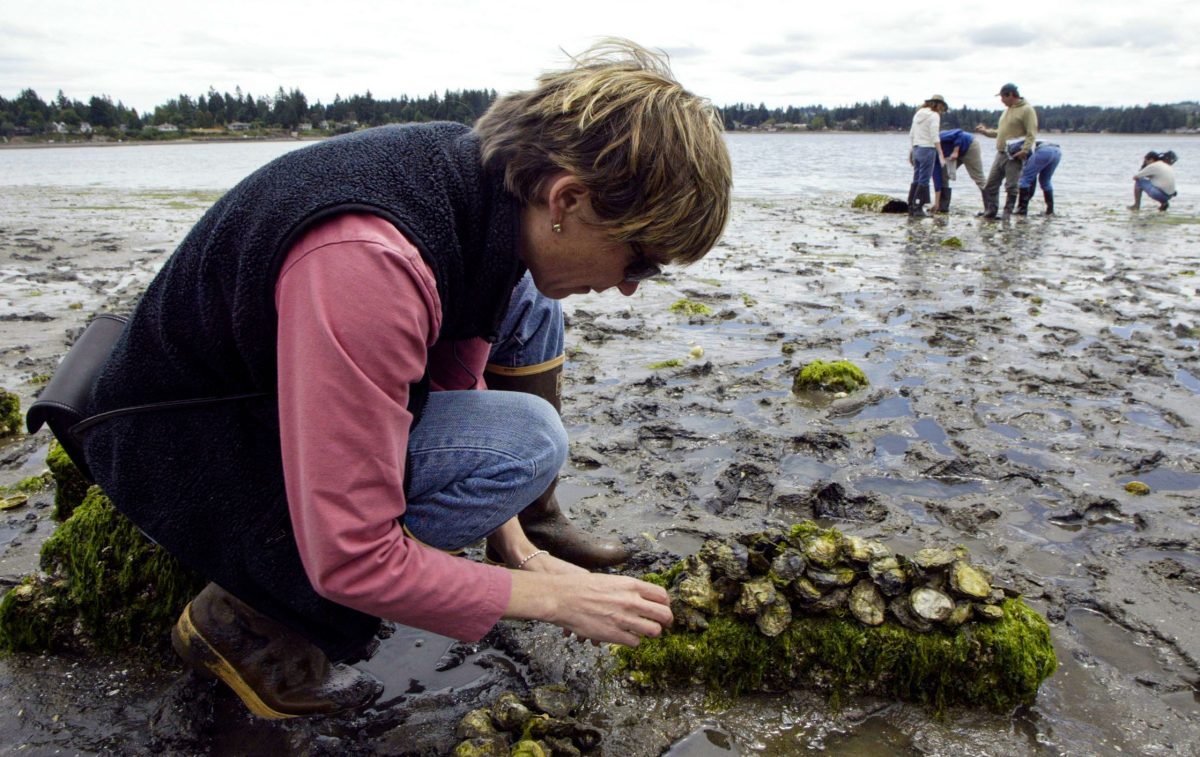
Betsy Peabody of the Puget Sound Restoration Fund has worked to restore Olympia oysters to Washington State for decades. Here she is in 2006 with a mat of Olys. Photo by Jim Bryant/AP Photo
Some of the most persuasive arguments for restoring oysters around the world often come down to their benefits to both people and the ecosystem. For Olympia oysters, one challenge is the perception that they never played a major role in coastal ecosystems. Unlike the substantial reef mounds of the Atlantic oysters that are visible from space, Olys mostly stitch themselves together into smaller, low-lying mats. That doesn’t mean they aren’t creating habitat for other species—they are, just on a smaller scale. As for their clean-water benefits, Olympia oysters do filter the water, though, admittedly, no more efficiently than the non-native Japanese oysters.
For the Olys, one of the most persuasive reasons to restore them is that they belong here, and bringing them back isn’t like resurrecting the Tasmanian tiger or the wooly mammoth. Although Oly populations are undoubtedly lower than they once were, they are still hanging on in most parts of their range. They just need a helping hand—typically, a better substrate for their spat to settle on to increase survivorship.
Over the last decade, at least 39 Olympia oyster restoration projects have gotten off the ground, according to the Native Olympia Oyster Collaborative. That’s an increase from the 24 projects launched the previous decade. Most of these projects are small efforts, costing a few hundred thousand dollars and covering less than a hectare. But they are making a difference: most of the projects that kept track of oyster numbers and densities over time have reported success.
One of the places where restoration hasn’t been so quick or easy is Elkhorn Slough, a couple of hours’ drive south of San Francisco. Surrounded by coast redwoods and strawberry fields, the waterway wends its way along the base of the coastal hills and opens up into Monterey Bay.
The wetlands were once an abundant source of oysters. In the 1800s, San Franciscans would periodically come out to harvest them. But the building of levees, including one to support railroad tracks, reduced some of the tidal flow, and by the early 1900s, landowners had filled in the marsh wherever they could to expand grazing land for dairy farming and crops. The mud has since become so deep and the sediment flow so goopy that anything placed in the slough gets quickly buried. There are now so few oysters here that they fail to breed in most years.
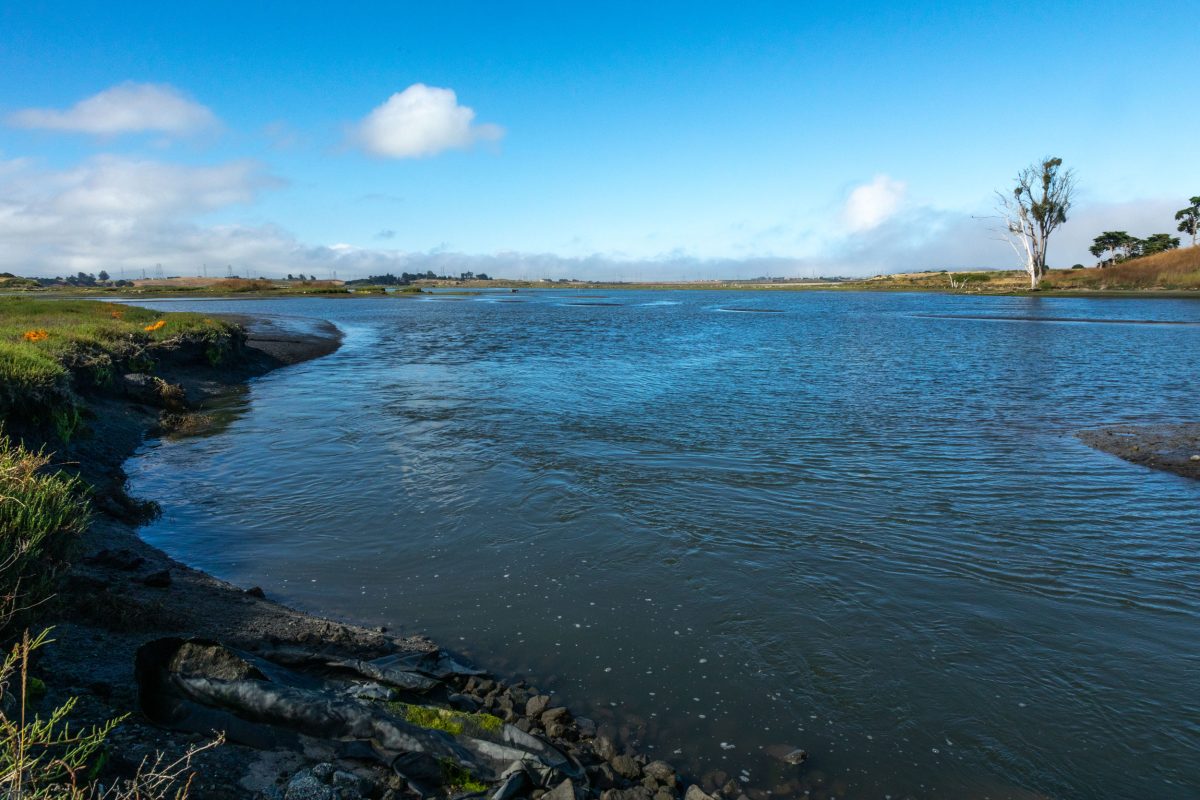
An Olympia oyster restoration at Whistlestop Lagoon in Elkhorn Slough, California. Photo by Luciane Coletti
Kerstin Wasson, research coordinator of the Elkhorn Slough National Estuarine Research Reserve, measures recruitment by setting out saucer-sized ceramic tiles from Home Depot and checking them for any settlement. Last year, out of 50 tiles, Wasson found a single oyster. “That’s pretty typical,” she says. Other sites on the central California coast—Tomales Bay, north of San Francisco, for instance—are also among those most at risk of disappearing. And a modest oyster population at Point Mugu, near Malibu, is probably at risk, too. If restoration fails at Elkhorn, there will be a 600-kilometer gap between the populations in Southern California and those to the north.
I meet Wasson at the reserve during an oyster restoration event I’m joining, along with around a dozen volunteers from the local community. Wasson’s team has filled two family-sized coolers with juvenile Olympia oysters—the offspring of adults collected from the estuary years earlier. They have been reared at the nearby Moss Landing Marine Laboratories and allowed to settle on shells and tiles. In 2017, after more than 15 years working at Elkhorn Slough, Wasson launched a hatchery program as a last resort to boost the Oly population. It requires growing algae in sterile bioreactors for the captive oysters and feeding it to them multiple times a day—a labor-intensive process.
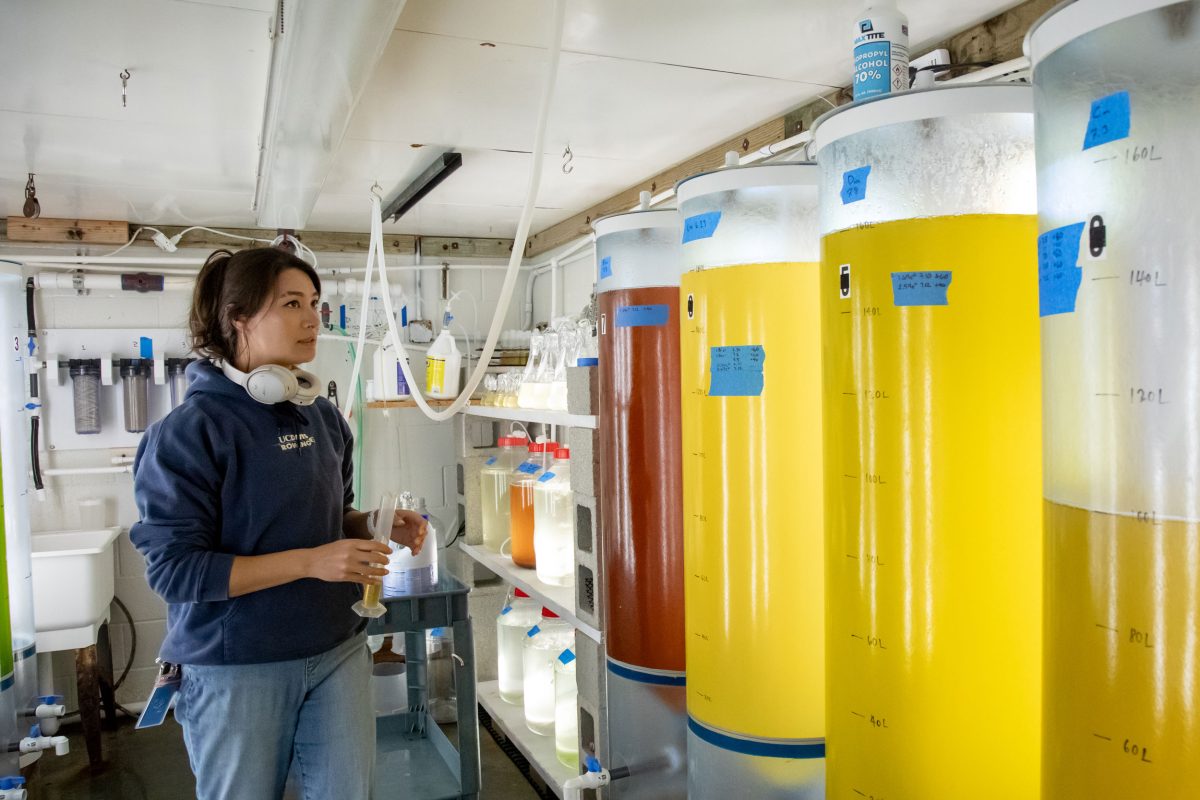
Celine de Jong maintains the microalgae production in the hatchery at Moss Landing Marine Laboratories. Photo by Luciane Coletti
Many marine species commonly breed in late spring and summer, when the algae at the bottom of the food chain are most abundant, giving their young ones the best chance of success. In captivity, aquaculturists coax the Olys to reproduce by gradually warming the water, but it’s tricky. The oysters’ habit of switching back and forth between the sexes multiple times in their lives is a constant frustration to their captors, who need to make sure there are always enough males in each tank. During their male phase, Olympia oysters breed by broadcasting millions of sperm into the water, and they have to be relatively close to females—about a meter—for fertilization to take place. Unlike Atlantic oysters, which release their eggs during spawning, Olympia oysters are brooders, keeping fertilized eggs inside their shells for one to two weeks of development before releasing them.
The hatchery experts at Moss Landing, led by an Australian named Luke Gardner, have borrowed some techniques from commercial growers. One of the key differences is that commercial growers are trying to raise individual oysters that diners think will look good on a bed of crushed ice. Conservationists, on the other hand, want to grow clusters of shells. Such starter reefs have more staying power when they are placed directly in a watery environment. In their tanks, some of the oyster spat are allowed to settle on tiles, others on spent shells, and others on long branches coated with an oyster-shell mimic, calcium carbonate, to attract the gregarious oysters. Wasson is still in the process of identifying the optimal method for restoration.

Volunteers attached young Olys to tiles during a community-based oyster restoration bee at Elkhorn Slough. Photo by Luciane Coletti
At the slough, I watch the volunteers assemble oyster poles—roughly two-meter lengths of PVC with six shells or tiles dangling by a couple of zip ties from one end. The volunteers start by counting the number of oysters on each shell (or tile). The counting is tricky for the untrained eye: one team tallies 29, but when the experts double-check, they identify about 47 little guys, all crammed together.
“When they’re covered in slime, do we just count through the slime?” asks one volunteer.
“I need professional help,” says another volunteer. “Is this one or two, or just bird shit?”
After an hour of this, several dozen oyster poles have been assembled. Wasson heads out into the waist-deep water with her team and uses a rubber mallet to pound each pole partway into the mud one after another as if driving in fence posts. The oysters dangle millimeters above the water’s surface. The group has just added over 6,000 juvenile oysters, doubling the estimated population in the slough. “My goal is to get a million oysters into this estuary,” Wasson says.
It sounds absurd, considering that only half the oysters the volunteers have just put out will make it through their first year, but Wasson believes her goal can be reached over the next 10 years. Once the oysters reach a critical mass, they’ll no longer need her help. “A million is not like a Mars mission,” she adds.
Wasson hands out her homemade chocolate chip cookies to the volunteers before they depart that afternoon. I head up the trail and back to my truck. I look back one last time. The tide will soon come in. One by one, those little oysters will crack their shells open and start cleaning the water as best as they can. They may not be much to look at, but they are our oysters, our Pacific oysters.

